
Memento Mori: 1 2 3 4 5 6 Next>>
Memento Mori in the Golden Age of Piracy, Page 1
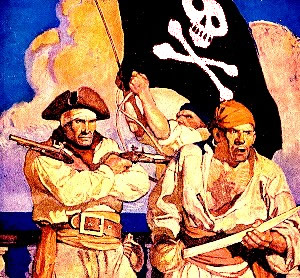
Artist: N.C. Wyeth
Treasure Island Cover With Pirate Flag (1911)
Memento mori is a Latin phrase that roughly means "Remember you will die" or simply "Remember death". The idea behind the use of memento mori in art and literature was variously interpreted throughout history, although during the golden age of piracy it generally meant that people should not become attached to the things of this world because they would eventually die and pass into the next world, leaving everything behind. Several other Latin phrases were often tied to the concept of memento mori such as 'memento mortis' ('remember death'), 'Hora fugit' ('The hour flees'), Tempus fugit ("Time flies')1, 'Vita fugitur" ('Life is fleeting), 'Aesterna respice' ('Look upon eternity'), and 'Incerta hora' ('The hour of death is uncertain')2.
This article begins with a brief look at the history of memento mori in human culture, moving on to examine some of the symbols chosen to represent death and the memento mori concept. From there, we will look at various representations of memento mori in art during the 12th through early 18th centuries, moving on to focus particularly on how memento mori concepts appeared during the golden age of piracy in jewelry, anatomy books and, finally, pirate flags. (Although it was probably not as widely represented during the period on pirate flags as it has been in modern depictions as we shall see.)
Memento mori and it's symbolism permeated the late 17th and early 18th century culture. Although this material is being presented in a way that may suggest it was a cohesive artistic movement from the time period, it is my impression that it is anything but cohesive. Rather, reminders of death appeared in various medium for various reasons at this time in history.
1 Steve Burkle, "Memento Mori - The Symbol of the Skull with Crossed Bones", www.freemasons-fremasonry.com, gathered 9/20/14; 2 Audrey, "Skulls, Skeletons and Snakes - A Brief History of Memento Mori and Memorial Jewelry, Primaveragallery.com, gathered 10/4/14
History of Memento Mori
Legend
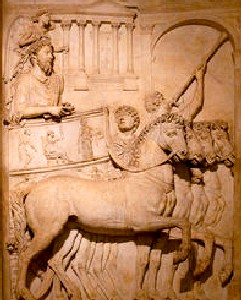
Artist: Matthias Kabel
Marcus Aurelius
Roman Triumph, Bas
Relief From Arch of Marcus Aurelius
holds that the phrase 'memento mori' was an integral part of a Roman ceremony referred today as the 'Roman triumph'. This was a religious and civil ceremony to celebrate and sanctify a military commander who had led the Roman forces to victory. The commander was paraded through the streets in chariot drawn by four horses, wearing a crown of laurel and a purple and gold toga. His army, captives and other spoils of the battle were paraded with him as testament to the victory, suggesting he was near-divine.
To counter this, some accounts of Roman triumphs say that "a companion or public slave would, from time to time, remind him of his own mortality (a memento mori)."1 This person was "tasked with reminding the general that, although at his peak today, tomorrow he could fall, or — more likely — be brought down."2
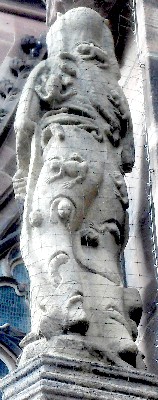
Photo: Jevee Blau
The Back of Lady World,
Beset by Snakes, Worms
and Creeping Things,
Worms Cathedral (14th c.)
While the humbling aspect of memento mori art is certainly the most widely discussed reason for its existence, it was not the only way it could be viewed. Followers of the Greek philosopher Epicurus in the 4th and 3rd century BC, when "faced with the inevitability of death, made the most of the pleasures of life and decorated their glass, ceramics and silver with emblems of mortality in the same spirit with which the poet Martial [1st century Roman poet Marcus Valerius Martialis] wrote that 'Joys never linger, they take wings and fly, Grasp them with both hands, take them for yours, hug them closer, even so they often slip away.'"3
However, this hedonistic view of death was eventually supplanted by the Christian view that things of this world are passing and their impending death should inspire people to behave morally. This dates all the way back to biblical times. The book of Sirach in the advises the reader, "Remember at all times what thou must come to at the last, and thou shalt never do amiss."4 Further on, it builds upon this idea by explaining that "the king that reigns to-day will be dead to-morrow. And what is the new kingdom he inherits? Creeping things, and carrion beast, and worm."5 Genesis provides what is perhaps the most penetrating comment, "dust thou art, and unto dust shalt thou return."6
Wikipedia explains, "In the Christian context, the memento mori acquires a moralizing purpose quite opposed to the Nunc est bibendum (now is the time to drink) theme of Classical antiquity. To the Christian, the prospect of death serves to emphasize the emptiness and fleetingness of earthly pleasures, luxuries, and achievements, and thus also as an invitation to focus one's thoughts on the prospect of the afterlife."7
1 Roman triumph, wikipedia.com, gathered 10/4/14; 2 Memento mori, wikipedia.com, gathered 9/21/14; 3 Diana Scarisbrick, Rings: Jewelry of Power, Love and Loyalty, p. 161; 4 Sirach: 7:40, New Advent Bible, gathered 10/4/14; 5 Sirach: 10:12-13, gathered 10/6/14; 5 Genesis 3:19, gathered 10/6/14; 7 Memento mori, wikipedia
History of Memento Mori: Underpinnings
While the the actions encouraged by the viewer of these reminders of one's death are interesting, they do not explain how and when the memento mori art form came to be embraced by society when it did. In his book Medieval Death: Ritual and Representation, Paul Binski suggests two different cultural motivations for "death as an organizing belief", which led to the eventual rise of memento mori art: an internal and an external factor.1
The first internal factor Binski identifies is the rise of the recognition of the individual within what had previously been a collectively-focused society. "With the rise of the individual came a renewed sense of the individual in history, of the individual in life; and with that realization came its correlate, the sense of loss, of failure in death."2
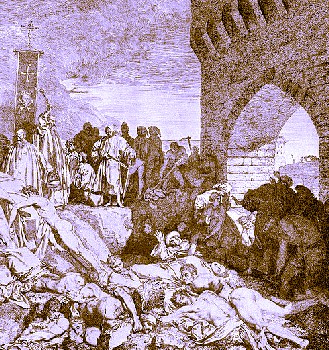
Artist: Luigi Sabatelli
The Plague of Florence in 1348, As Described in
Boccaccio's Decameron (19th c. Engraving)
This concept developed in the 12th century and was aided by a second internal factor born "in a culture of fear, of an ultimately monastic notion of Christian-moral penitential thinking."3 Here, the Bible passages cited above provide a focus on the human existence as a temporary one which will inevitably result in death. The intent here was to inspire a focus on higher things and promote moral behavior.
Binski's external factor recognizes the impact of "late medieval demographic disasters, most especially the Black Death"4. He points out that the plague, which recurred throughout the late 14th century, is believed to have killed off between 1/3 and 2/3 of the population in the areas it affected.5 As Binski explains, "The practical consequences of the plague were marked: mass population falls led to a drop in agricultural prices, to a rapid rise in wages, and to an unprecedented redistribution of wealth. ...Art production, like any industrial output, suffered a clear and obvious breach in continuity, with long-established masters ...perishing in the main outbreak of the plague in the late 1340s."6
I find the external theory to be much more satisfying in its explanation of how macabre forms of art came to be accepted in society. With widespread exposure to death for an extended period of time and dramatic shifts in the population, the acceptance of such a shocking art form seems quite possible. However, as Binski points out, the roots of macabre art go further back than the plagues. Like most new concepts, the origin of memento mori were probably generated and encouraged by the internal factors - the recognition of the individual vs. the collective and rise of the guilt-culture. However, widespread societal acceptance of the art form was likely triggered by events such as the plague, which made these horrific images more palatable.
1 Paul Binski, Medieval Death: Ritual and Representation, p. 126; 2,3 Binski, p. 131; 4,5,6 Binski, p. 127
History of Memento Mori: 16th and 17th Centuries
Binski's book focuses primarily on what he calls "macabre art", a style that was prevalent in the 12th through 16th centuries. Philippe Aries explains that this style was different than the later memento mori art which surfaced in the 16th century and continuing to grow in popularity throughout the 17th and early 18th centuries. Aries notes that while the difference between the the macabre and memento mori art is subtle, it still exists. "Beneath the illusion of permanence [of the macabre art form] a new attitude is beginning to appear, or, if not a new attitude, an unconscious devaluation of the old attitudes."1
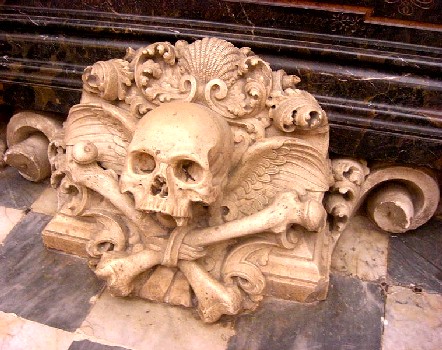
Photographer: Ana Rey
Detail from the Tomb of Cardinal Salazar, Mosque of Cordoba (1709-10)
Note the Clean, Disembodied Bones and Addition of Symbolic Wings
And Other Flourishes
Aries finds that the subtle difference involves the appearance of the memento mori objects themselves.
The purpose of the macabre [art] was no longer to reveal the subterranean work of corruption. The horrible transi [Aries' word for 'a half decomposed corpse'], the naked cadaver being eaten by worms and bitten by snakes and toads, was replaced by the beautiful skeleton, clean and gleaming, the morte secca [dry corpse] with which children still play today on All Souls' Day in Italy and all year around in Mexico.2
Eventually, the full skeleton was disassembled, leaving the head and bones loose as a less grisly, more clinical and symbolic, reminder of mortality. This was "combined with other symbols such as the hourglass, the church clock, the scythe, or the gravedigger's shovel. These symbols invaded not only funerary art but also those familiar objects that were the vanities [pictures and objects that evoked the passage of time]."3
The purpose of macabre art, particularly in the form of memento mori shifted from a moralizing medium directed at society to a more personal focus which encouraged "individuals to consider their own temporal nature and the personal meaning of mortality."4 This highlights the growth of the internal factor which recognized the independence of the individual within the greater mass of society. Aries suggests that the result of this shift in consciousness means, "Death is now an intrinsic part of the fragile and empty existence of things, whereas in the Middle Ages death came from the outside."5 As a result, the artwork of memento mori is of a more personal nature, directed at the individual, which helps explains why it took the form of personal possessions such as vanities and jewelry.
1 Philippe Aries, The Hour of Our Death, p. 297; 2 Aries, p. 328; 3 Carlton Hobbs, "The Memento Mori Theme in European Art", slideshare.net, gathered 10/6/14; 4,5 Aries, p. 332
Memento Mori Symbolism
Memento mori art is defined by the symbols that appear in it. Some of the
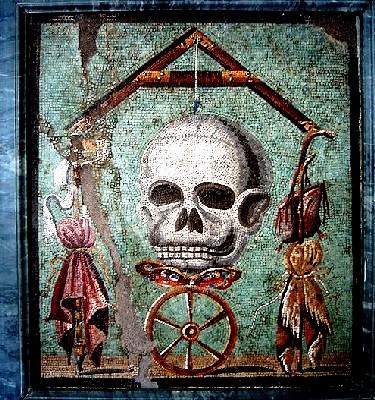
Memento Mori Mosaic, Pompeii
symbols are obvious and fairly universal, while others are less so. Some memento mori icons seem only to appear in individual artistic movements or mediums, while others, such as the skull, are universal. As a result, when classifying artwork as being a representation of memento mori, even the 'experts' don't always seem to completely agree on whether a piece should be considered a representation of memento mori or not.
Some of the memento mori symbols date to antiquity. A mosiac from Pompeii believed to have been created between 30 B.C. and 14 A.D. includes some very familiar memento mori icons along with some that were not as popular during the golden age of piracy.
Seen here, the basic theme of the mosiac is that 'death is the great leveler', a popular motif in memento mori art. The skull is the most readily identifiable symbol, representing death. Above it, there is a balance scale with a plumb line hanging from it. The plumb line and the wooden level at the top identify death as the great leveler. The wheel at the bottom is the wheel of fortune, which makes the rich poor and the poor rich. Off the ends of the level "hang in perfect equilibrium the symbols of power (the sceptre and the royal purple) and on the right, the sack and the stick, symbols of poverty."1 The Skull is resting atop a butterfly, which represents the transience of life.
The list of memento mori symbols given here include some of the more popular icons found around the time of the golden age of pirates in art and jewelry. It is far from complete, but meant only to provide an overview of the more popular icons.
Arrow/Dart - Indicates mortality2. On gravestones, may indicate the person died of the plague.3
Bubble - The transience of life.
Butterfly - The "brevity and the ephemeral nature of life"4 (Often associated with vanitas art.)
Coffin – Death; the end of life.
Cornucopia - A fruitful life.5
Dying flowers - The transience of life.
Gravedigger Tools - picks, shovels, winding sheet, etc. - Mortality.
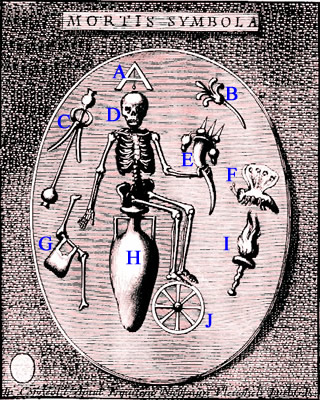
Various Symbols of Death, From Collectanea Antiquitatum
Romanarum, by Anthony Borioni, p. 239 (1736)
A - Plumb line, B - Dying Flower, C - Nipping Poppy with Tongs,
D - Skeleton, E - Cornucopia, F - Butterfly, G - Wallet on Bones,
H - Funery Urn, I - Torch Going Out, J - Wheel of Fortune
Hourglass- The "passage of time or that time has run out for the individual buried at the location. Its use associated with personified figures of Death and Father Time comes out of a long tradition of mortuary symbolism. Rarely used alone, it usually appeared along with hearts, stars, leaves and sacred flowering vines. It was also the frequent companion of winged death's-heads and bones."6
Hourglass with Wings - Time Flying; Short Life.7
Musical Instruments - The "brevity and the ephemeral nature of life" - like music itself.8 (Often associated with vanitas art.)
Poppies - Peace, rest, sleep, eternal sleep, consolation.
Plumbline/Level - Death as the great leveler.
Rotten Fruit - The "brevity and the ephemeral nature of life".9 (Often associated with vanitas art.)
Scythe/Hatchet – "The scythe is carved on gravestones to symbolize the cutting of life or the chopping down of one's life. A scythe is used to cut down crops during the harvest, which has an obvious parallel with the end of a human life. As a result, the scythe is often related to the Grim Reaper; whose main job is to take others' lives. The scythe reminds us of death and how life can be cut short."10
Serpents, Worms – Temporariness of the body, uselessness of vanity.
Smoke - Brevity of life.11
Skull, Skeleton, Bones, Crossed Bones - The skull, bones and crossed bones are the most widely recognized symbol of death and certainly one of the most popular images seen in memento mori artwork.
Torch-"Lit or upright torch represents life, the inverted or extinguished - death."12
Urn -"Greek symbol of mourning, the body as a vessel of the soul, originating as a repository for the ashes of the dead in ancient times - a popular symbol of mourning."13
Watch - Transience of life.
Wealth – Various symbols including wallets, crowns, fine clothing, etc. - Used to show the irrelevance of material goods after death.
Wings, Winged skull – "Flight of the soul from mortal man."14
Wheel – Wheel of fortune.
1 "The Skull and the Level Translated", MosaicArtNow.com, gathered 10/5/14; 2 Minda Powers-Douglas, "Symbols Found on Gravestones, TheCemeteryClub.com, gathered 10/5/14; 3 Douglas Keister, Stories in Stone, p. 128; 4 Vanitas, Wikipedia.com, gathered 10/5/14; 5 Powers-Douglas, gathered 10/5/14; 6 "Grave stones – winged skulls & memento mori", ettc.net, gathered 10/5/14; 7 Powers-Douglas, gathered 10/5/14; 8, 9 Vanitas, gathered 10/5/14; 10 "Grave stones – winged skulls & memento mori", gathered 10/5/14; 11 Vanitas, gathered 10/5/14; 12, 13,14 Powers-Douglas, gathered 10/5/14;

